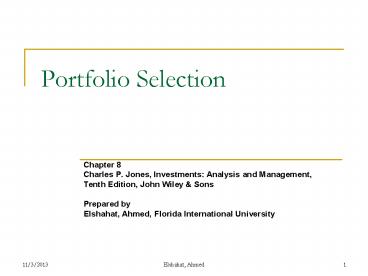Portfolio Selection - PowerPoint PPT Presentation
1 / 19
Title:
Portfolio Selection
Description:
Portfolio Selection Chapter 8 Charles P. Jones, Investments: Analysis and Management, Tenth Edition, John Wiley & Sons Prepared by Elshahat, Ahmed, Florida ... – PowerPoint PPT presentation
Number of Views:1005
Avg rating:3.0/5.0
Title: Portfolio Selection
1
Portfolio Selection
- Chapter 8
- Charles P. Jones, Investments Analysis and
Management, - Tenth Edition, John Wiley Sons
- Prepared by
- Elshahat, Ahmed, Florida International University
2
Building a Portfolio Using Markowitz Principles
- Identify optimal risk-return combinations
available from the set of risky assets being
considered. - Tool Markowitz efficient frontier analysis.
- Input expected returns, variances, covariances
- Select the optimal portfolio from among those in
the efficient set. - Criteria investor's preferences
3
1 Identifying Optimal Risk-Return Combinations
- Assumptions
- A single investment period
- Liquidity of positions (no transaction cost).
- Investor preferences is based only on portfolio's
expected return and risk. - Steps
- The Attainable Set of Portfolios
- Efficient Portfolios
- The Efficient Set
4
The Attainable Set of Portfolios
- Determine the risk-return opportunities
available. A large number of possible portfolios
exist.
- The attainable (opportunity) set is the entire
set of all portfolios that could be found from a
group of n securities. - Risk-averse investors should be interested only
in those portfolios with the lowest possible risk
for any given level of return.
5
Efficient Portfolios
- Portfolio that has the smallest portfolio risk
for a given level of expected return or the
largest expected return for a given level of risk
- Given the minimum-variance portfolios, we can
plot the minimum-variance frontier as shown in
this Figure. - X dominates Y.
6
The Efficient Set (Frontier) (AB)
- The efficient set is determined by the principle
of dominance portfolio X dominates portfolio Y
if it has the same level of risk but a larger
expected return, or the same expected return but
a lower risk.
- The solution to the Markowitz model revolves
around the portfolio weights
7
Understanding the Markowitz Solution
- Think of efficient portfolios as being derived in
the following manner - Inputs Determine the Required E(R), 10.
- Create all portfolios that can yield 10.
- Choose the one with the lowest risk.
- Determine anther Required E(R), 11.
- Continue the process.
8
2 Selecting an Optimal Portfolio of Risky
Assets
- Markowitz model does not specify one optimum
portfolio. Rather, it generates the efficient set
of portfolios, all of which, by definition, are
optimal portfolios.
- Indifference Curves describe investor
preferences for risk and return. - Each indifference curve represents the
combinations of risk and expected return that are
equally desirable to a particular investor.
9
Indifference Curves Properties
- Indifference curves cannot intersect
- Investors have an infinite number of indifference
curves - The curves for all risk-averse investors will be
upward-sloping, but the shapes of the curves can
vary depending on risk preferences. - Higher indifference curves are more desirable
than lower indifference curves. - The greater the slope of the indifference curves,
the greater the risk aversion of investors. - The farther an indifference curve is from the
horizontal axis, the greater the utility.
10
Selecting the Optimal Portfolio
- The optimal portfolio for a risk-averse investor
is the one on the efficient frontier that is
tangent to an investor's indifference curve that
is highest in return-risk space.
11
SOME IMPORTANT CONCLUSIONS ABOUT THE MARKOWITZ
MODEL
- Markowitz portfolio theory is referred to as a
two-parameter model. - The Markowitz analysis generates an entire set of
efficient portfolios, all are equally good. - The Markowitz model does not address the issue of
investors using borrowed money - Different investors will estimate the inputs to
the Markowitz model differently. - The Markowitz model remains cumbersome to work
with because of the large variance-covariance
matrix
12
Alternative Methods of Obtaining the Efficient
Frontier SIM MIM
- THE SINGLE-INDEX MODEL (SIM) relates returns on
each security to the returns on a common index.
13
THE SINGLE-INDEX MODEL
- The single-index model divides a security's
return into two components - Micro event A unique part, represented by ai,
affecting an individual company but not all
companies in general. - Macro event A market-related part represented by
ßiRM, broad-based and affects all (or most)
firms. - Error term
14
Critical Assumption of the SIM
- Securities are related only in their common
response to the return on the market (the
residual errors for security i are uncorrelated
with those of security j). - It implies that stocks covary together only
because of their common relationship to the
market index. - There are no influences on stocks beyond the
market, such as industry effects. - Thus, covariance depends only on market risk.
15
Splitting Risk into Two Parts
16
The Asset Allocation Decision
- The allocation of portfolio assets to broad asset
markets. - How much of the portfolio's funds are to be
invested in stocks, how much in bonds, money
market assets, and so forth. - Some Major Asset Classes
- International Investing
- Bonds
- Treasury Inflation-Indexed Securities.
- Real Estate
17
COMBINING ASSET CLASSES
18
The Impact of Diversification on Risk
19
How Many Securities Are Enough to Diversify
Properly?
- As few as 20 stocks could be adequate































